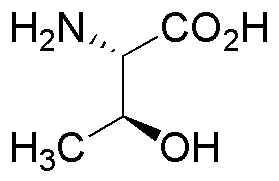L-allo-Threonine is widely utilized in research focused on:
- Animal Nutrition: This amino acid is often added to animal feed to enhance growth and improve overall health in livestock, particularly in poultry and swine industries.
- Pharmaceuticals: It serves as a building block in the synthesis of various therapeutic agents, contributing to the development of medications that target metabolic disorders.
- Biotechnology: Researchers use L-allo-Threonine in protein engineering to create modified enzymes with improved stability and activity, which can be crucial for industrial applications.
- Food Industry: It is incorporated into dietary supplements and functional foods aimed at improving nutritional profiles, especially for those with specific dietary restrictions.
- Research Studies: Used in various biochemical studies to investigate metabolic pathways and protein interactions, providing insights into cellular functions and disease mechanisms.
General Information
Properties
Safety and Regulations
Applications
L-allo-Threonine is widely utilized in research focused on:
- Animal Nutrition: This amino acid is often added to animal feed to enhance growth and improve overall health in livestock, particularly in poultry and swine industries.
- Pharmaceuticals: It serves as a building block in the synthesis of various therapeutic agents, contributing to the development of medications that target metabolic disorders.
- Biotechnology: Researchers use L-allo-Threonine in protein engineering to create modified enzymes with improved stability and activity, which can be crucial for industrial applications.
- Food Industry: It is incorporated into dietary supplements and functional foods aimed at improving nutritional profiles, especially for those with specific dietary restrictions.
- Research Studies: Used in various biochemical studies to investigate metabolic pathways and protein interactions, providing insights into cellular functions and disease mechanisms.
Documents
Safety Data Sheets (SDS)
The SDS provides comprehensive safety information on handling, storage, and disposal of the product.
Product Specification (PS)
The PS provides a comprehensive breakdown of the product’s properties, including chemical composition, physical state, purity, and storage requirements. It also details acceptable quality ranges and the product's intended applications.
Certificates of Analysis (COA)
Search for Certificates of Analysis (COA) by entering the products Lot Number. Lot and Batch Numbers can be found on a product’s label following the words ‘Lot’ or ‘Batch’.
*Catalog Number
*Lot Number
Certificates Of Origin (COO)
This COO confirms the country where the product was manufactured, and also details the materials and components used in it and whether it is derived from natural, synthetic, or other specific sources. This certificate may be required for customs, trade, and regulatory compliance.
*Catalog Number
*Lot Number
Safety Data Sheets (SDS)
The SDS provides comprehensive safety information on handling, storage, and disposal of the product.
DownloadProduct Specification (PS)
The PS provides a comprehensive breakdown of the product’s properties, including chemical composition, physical state, purity, and storage requirements. It also details acceptable quality ranges and the product's intended applications.
DownloadCertificates of Analysis (COA)
Search for Certificates of Analysis (COA) by entering the products Lot Number. Lot and Batch Numbers can be found on a product’s label following the words ‘Lot’ or ‘Batch’.
*Catalog Number
*Lot Number
Certificates Of Origin (COO)
This COO confirms the country where the product was manufactured, and also details the materials and components used in it and whether it is derived from natural, synthetic, or other specific sources. This certificate may be required for customs, trade, and regulatory compliance.


